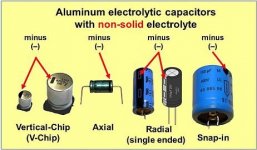360alaska
Well-known member
Radial vs Axial,
Radial: Leads come out of the bottom
Axial: Leads come out the sides

Technically, what Uniserver did here is alright as long as it fits, It's OK to do this but it's ugly and it makes those caps look like they don't belong. The other thing to consider is that some expansion boards may not fit, but if your ok with it it's fine...
Radial: Leads come out of the bottom
Axial: Leads come out the sides

Technically, what Uniserver did here is alright as long as it fits, It's OK to do this but it's ugly and it makes those caps look like they don't belong. The other thing to consider is that some expansion boards may not fit, but if your ok with it it's fine...
Last edited by a moderator:

